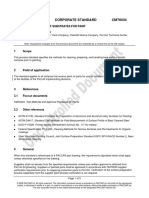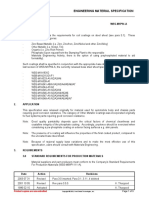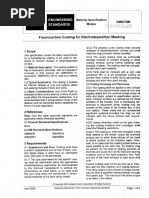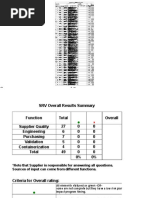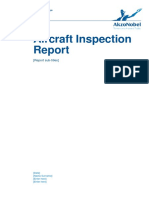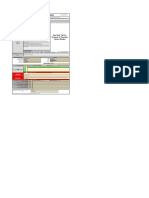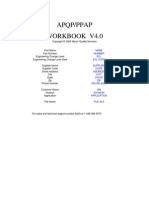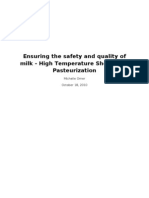AS10169
AS10169
Uploaded by
JOECOOL67Copyright:
Available Formats
AS10169
AS10169
Uploaded by
JOECOOL67Original Description:
Copyright
Available Formats
Share this document
Did you find this document useful?
Is this content inappropriate?
Copyright:
Available Formats
AS10169
AS10169
Uploaded by
JOECOOL67Copyright:
Available Formats
Chrysler Group LLC Document Number: AS-10169
Appearance Standard Date Published: 2010-07-19
Category Code: S-4 Change Level: B
EASL Requirement: Yes
Restricted: No
SURFACE APPEARANCE REQUIREMENTS FOR FASCIAS AND EXTERIOR COMPONENTS
1.0 GENERAL
1.1 Purpose
This standard, UNLESS OTHERWISE SPECIFIED by the Product Team, describes exterior surface
appearance requirements. These requirements, with regard to appearance attributes and surface
blemishes, are outlined by appearance zones.
1.2 Coverage of this Standard
The purpose of these appearance requirements is to ensure that the finish of vehicles will meet or exceed
customer expectations, Engineering, and Design Office intent.
1.3 Limitations on Usage
This standard focuses only on the visual/tactile characteristics of the components. Dimensional,
functional or material requirements are not considered.
The requirements of this standard apply from the dates assigned in the Color Master Program Timing
Definitions through volume production and service supply.
This standard, UNLESS OTHERWISE SPECIFIED, represents the minimum requirements for all Chrysler
platform groups, component suppliers and sub-suppliers.
1.4 Location of Definitions/Abbreviations/Acronyms
Definitions/Abbreviations/Acronyms can be found in Section 7.0 toward the end of this standard.
2.0 SPECIAL TEST EQUIPMENT
X-Rite multi-angle spectrophotometer is the approved measuring method by the Product Design Office.
TABLE 1: SPECIAL TEST EQUIPMENT
Name Of Item Description Make/Model (1)
X-Rite Multi-angle Spectrophotometer
NOTE 1: If applicable.
3.0 AUDIT PROCEDURE***
Visual inspection, UNLESS OTHERWISE SPECIFIED, shall be in body position at a minimum distance of
1 meter (approximately 38 in).
AS-10169, Change B, 2010-07-19, Page 1
Copyright Chrysler Group LLC
(08-06-2007)
3.1 Requirements for Appraisers
Any person appraising color must be tested for the absence of color blindness and demonstrate color
acuity per ASTM-E-1499.
3.2 Training
Training programs should be implemented to educate operators, inspectors, and managers in the
techniques and acceptability standards of this specification.
3.3 Light Intensity
In the inspection area, the light intensity shall be 80 to 125 maintained foot-candles.
3.4 Inspection Area
The Inspection Area shall comply with SAE-J-361.
3.5 Lighting Requirements for Color Match
Lighting for color match shall comply with SAE-J-361.
4.0 QUALITY REQUIREMENTS FOR APPEARANCE ATTRIBUTES APPEARANCE ZONES
A. The components are divided into different appearance zones/class to set the appearance quality
requirements of each zone separately.
TABLE 2: GENERAL APPEARANCE ZONES/SURFACE CLASS***
ZONE/
DESCRIPTION EXAMPLE
CLASS
A Exterior surfaces that can be viewed from approximately All components.
one (1) meter (38 in) distance away from the vehicle,
while standing, to a height of 2 meters ( 78 inches)
B Limited visibility surfaces. Surfaces not in direct view. Underside of parts, recessed
Surfaces above 2 meters ( 78 inches) areas, or area of part visible when
doors, trunk lid, or hood is open.
C Non-visible areas. Back side of any part.
Any area of a painted surface that is permanently
covered by another part.
B. Paint gloss, distinctness of reflected image (DORI) and orange peel gloss, DORI, and orange peel can
be measured and tracked individually, however, results can be reported as a combined Autospect
reading.
The combined reading is a weighted measurement consisting of 20% gloss, 40% DORI, and 40% orange
peel. UNLESS OTHERWISE SPECIFIED, target values and tolerances are contained in Tables 3 and 4.
AS-10169, Change B, 2010-07-19, Page 2
Copyright Chrysler Group LLC
(08-06-2007)
TABLE 3: OVERALL AUTOSPECT
ZONE TARGET VALUES & TOLERANCES
Horizontal A 60 + 10 - 5
Vertical A 60 + 5, -10
B 50 + 10, -5
C 50 + 10, -10
4.1 Alternative Verification Methods
Alternative Gloss, DORI, and Orange Peel measurement methods are shown in Table 4.
TABLE 4: ALTERNATIVE VERIFICATION METHODS
Chrysler A.C.T.
INSTRUMENT TYPE BYK-GARDNER ATI/HUNTER DORIGON
PANEL
ZONE GLOSS DORI ORANGE PEEL
A 80 to 100 80 to 100 7 to 10
B 75 to 100 75 to 100 5 to 10
C 70 to 100 70 to 100 3 to 10
4.2 Uniformity
Appearance must be consistent over entire vehicle, both within individual panels and between adjacent
panels within a zone.
See Tables 3 and 4 for Gloss, DORI, and Orange Peel Uniformity.
The color shall not vary visually from the approved color master. Use of an X-Rite multi-angle
spectrophotometer is the approved measuring method by the Product Design Office. Target values and
tolerances for X-Rite shall be determined by the Product/Platform Team and specified on CATIA or in a
separate program manual.
Refer to CS-9801 for general quality requirements.
5.0 SURFACE BLEMISHES/IMPERFECTIONS
UNLESS OTHERWISE SPECIFIED, when combinations of different types of the following blemishes/
imperfections are present, all shall be treated as being of the type which has the most severe
requirements and the grouping must be within the acceptance level specifications for that type.
Any surface blemishes/imperfections that are less than 0.75 mm (.030 in), including swell or area
distortion, in size in Zone “A” will not be counted unless three (3) or more are grouped together in a 1
square centimeter (3/8 in sq) area. Minimum distance apart shall be 300 mm (12 in). Refer to Table 5 for
Zone “A” surface blemishes/imperfections.
AS-10169, Change B, 2010-07-19, Page 3
Copyright Chrysler Group LLC
(08-06-2007)
TABLE 5: SURFACE BLEMISHES / IMPERFECTIONS
FOR ZONE A
Description/ Max Max
Defect Definition Size Frequency Comments
Type
Surface Any noticeable foreign .75 mm (.030 3 max. Defects can be seen, but not
Irregulariti matter in, on, or under the in) dia. 6 max per be reasonably felt. Multiple
es paint or substrate surface. Including swell total part defects cannot be within the
300mm (12 in) minimum
distance.
Over Rough or gritty texture on Not Allowed Not Over spray restricted to Zone
Spray paint surface. Allowed C is acceptable.
Not Allowed
Polish Visible swirl or hazy marks Not Polish marks visible in Zone C
Marks caused by improper Allowed are acceptable.
polishing techniques.
Sags/Runs Excessive color coat or Not Allowed Not Sags/Runs visible in zone C
clear coat causing build up. Allowed are acceptable.
Mottle Disorientation of metallic Not Allowed Not Mottle visible in zone C is
flake causing shaded or off Allowed acceptable.
color appearance.
Sand Lines or swirls which can be Not Allowed Not Sand scratches are not
Scratches seen under the surface of allowed allowed if visible from a
the paint caused by distance of 1 meter (39 in)
improper sanding of the while component is in vehicle
primer. position.
Scratches Scratches on the surface of Not Allowed Not Scratches are not allowed if
the paint. allowed visible from a distance of 1
meter (39 in) while component
is in vehicle position.
Wet Mar Disturbances in a wet paint Not Allowed Not Wet Mar visible in zone C is
film prior to baking. allowed. acceptable.
File/Grind Cuts in the surface which Not Allowed Not File/Grind Marks are not
Marks can be seen under the allowed. allowed if visible from a
surface of the paint caused distance of 1 meter (39 in)
by poor file techniques or while component is in vehicle
improper repairs. position.
Paint chips Damage to the paint Not Allowed Not Paint chips are not allowed in
exposing primer, e-coat, or allowed any zone.
bare substrate.
Craters Small rounded indentations .75 mm (.030 3 max. Defects can be seen, but not
in the paint surface. in) dia. reasonably felt. Multiple
Including swell defects cannot be within the
300mm (12 in) minimum
distance.
Water The occurrence of circular .50 mm dia. 3 max.
Spots blemishes on a paint film (.020 in)
usually caused by improper
AS-10169, Change B, 2010-07-19, Page 4
Copyright Chrysler Group LLC
(08-06-2007)
TABLE 5: SURFACE BLEMISHES / IMPERFECTIONS
FOR ZONE A
Description/ Max Max
Defect Definition Size Frequency Comments
Type
dry-off of poor DI water
rinse.
Bullseyes Uneven surface Not
depressions which can be Not Allowed Allowed
seen or felt on a panel
usually caused by improper
sanding prior to painting.
Pits/Porosi Small holes in paint film. .75 mm dia. 3 max. Defects can be seen, but not
ty (.030 in) reasonably felt. Multiple
defects cannot be within the
300mm (12 in) minimum
distance.
Metal Shiny metal flakes in base .75 mm dia. 3 max. Defects can be seen, but not
Flakes color or clear coat. (.030 in) reasonably felt. Multiple
defects cannot be within the
300mm (12 in) minimum
distance.
Off Color Light or dark spots in color .75 mm dia. 3 max Defects can be seen, but not
Flakes coat caused by pigment. (.030 in) reasonably felt. Multiple
defects cannot be within the
300mm (12 in) minimum
distance.
Parting Excess material formed 0.15 mm hgt Not Refer to CS-8891
Line where core and cavity of 0.15 mm wdt Applicable
Flash mold meet. (.005 in)
Mold/Die Off-set condition between 0.15 mm Not Refer to CS-8891
Mis-match core and cavity sides of (.005 in) Applicable
mold.
Sink Uneven surface See comments See Size and frequency subject to
depressions which can be comments Chrysler Design Office and
seen or felt. Engineering approval.
Knit/Flow Disruption of surface See comments See Size and frequency subject to
Lines caused by improper comments Chrysler Design Office and
material flow. Engineering approval.
Any surface blemishes/imperfections that are less than 0.5 mm (.020 in), including swell or surface
distortion, in size in Zone “B” will not be counted unless five (5) or more are grouped together in a 1
square centimeter (3/8 in sq) area. Minimum distance apart shall be 150 mm (6 in). Refer to Table 6 for
Zone “B” surface blemishes/imperfections.
AS-10169, Change B, 2010-07-19, Page 5
Copyright Chrysler Group LLC
(08-06-2007)
TABLE 6: SURFACE BLEMISHES / IMPERFECTIONS
FOR ZONE B
Defect Description/ Max Max
Type Definition Size per Zone Comments
Surface Any noticeable foreign 1.0 mm (.040 3 max. Defects can be seen, but not
Irregulariti matter in, on, or under the in) dia. reasonably felt. Multiple
es paint or substrate surface. Including swell defects cannot be within the
300mm (12 in) minimum
distance.
Over Rough or gritty texture on Not Allowed Not Over spray visible in Zone C
Spray paint surface. Allowed is acceptable.
Polish Visible swirl or hazy marks Not Allowed Not Polish marks visible in Zone
Marks caused by improper Allowed C are acceptable.
polishing techniques.
Sags/Run Excessive color coat or 10 mm x 5 One Sags/Runs visible in zone C
s clear coat causing build up. mm (.040 in x are acceptable.
.200 in)
Mottle Disorientation of metallic Slight Only in Mottle visible in zone C is
flake causing shaded or off zone acceptable.
color appearance.
Sand Lines or swirls which can Not Allowed Not Sand scratches are not
Scratches be seen under the surface Allowed allowed if visible from a
of the paint caused by distance of 1 meter (39 in)
improper sanding of the while component is in vehicle
primer. position.
Scratches Scratches on the surface of Not Scratches are not allowed if
the paint. Not Allowed Allowed visible from a distance of 1
meter (39 in) while
component is in vehicle
position.
Wet Mar Disturbances in a wet paint Not Allowed Not Wet mar visible in zone C is
film prior to baking. Allowed acceptable.
File/Grind Cuts in the surface which Not File/Grind marks are not
Marks can be seen under the Not Allowed Allowed allowed if visible from a
surface of the paint caused distance of 1 meter (39 in)
by poor file techniques or when component is in vehicle
improper repairs. position.
Paint Damage to the paint Not Allowed Not Paint chips are not allowed in
chips exposing primer, e-coat, or allowed any zone.
bare substrate.
Craters Small rounded indentations 1.0 mm (.040 4 max. Defects can be seen, but not
in the paint surface. in) dia. reasonably felt. Multiple
Including swell defects cannot be within the
300mm (12 in) minimum
distance.
Water The occurrence of circular 2.0 mm dia. 4 max.
Spots blemishes on a paint film (.080 in)
AS-10169, Change B, 2010-07-19, Page 6
Copyright Chrysler Group LLC
(08-06-2007)
TABLE 6: SURFACE BLEMISHES / IMPERFECTIONS
FOR ZONE B
Defect Description/ Max Max
Type Definition Size per Zone Comments
usually caused by improper
dry-off of poor DI water
rinse.
Uneven surface 1.0 mm dia. 4 max.
Bulls eyes depressions which can be (.040 in)
seen or felt on a panel
usually caused by improper
sanding prior to painting.
Pits/Poros Small holes in paint film. .75 mm dia. 4 max.
ity (.030 in)
Metal Shiny metal flakes in base 1.0 mm dia. 4 max.
Flakes color or clear coat. (.040 in)
Off Color Light or dark spots in color 1.0 mm dia. 4 max.
Flakes coat caused by pigment. (.040 in)
Parting Excess material formed 0.20 mm hgt Not Refer to CS-8891
Line where core and cavity of 0.20 mm wdt Applicable
Flash mold meet. (.008 in)
Mold/Die Off-set condition between 0.20 mm Not Refer to CS-8891
Mismatch core and cavity sides of (.008 in) Applicable
mold.
Sink Uneven surface See See Size and frequency subject to
depressions which can be comments comments Chrysler Design Office and
seen or felt. Engineering approval.
Knit/Flow Disruption of surface See See Size and frequency subject to
Lines caused by improper comments comments Chrysler Design Office and
material flow. Engineering approval.
6.0 PAINT COVERAGE/PLATING/VACUUM METALIZATION***
Refer to applicable Material and Process Standards for paint/primer/E-coat film builds.
Paint coverage on zone/class A&B surfaces, defined in Table 2, must be complete, uniform, and meet all
Engineering and appearance specifications.
Refer to applicable Material and Process Standards for primer, E-Coat, plating, and vacuum metalization
surface quality, surface appearance, and surface smoothness requirements.
If any of the target values, or tolerances in Tables 3 and 4 cannot be achieved or are deemed
inappropriate, it is the responsibility of the Product Team to establish achievable and appropriate target
values and tolerances through material and process capability. It is the responsibility of the
Product/Release Engineer to ensure that any and all deviations are updated on CATIA.
If any of the target sizes, frequencies, or minimum distances of defects in any table cannot be achieved, it
is the responsibility of the Product Team to establish achievable and appropriate defect sizes, frequencies,
and minimum distances based on material and process capability. It is the responsibility of the
AS-10169, Change B, 2010-07-19, Page 7
Copyright Chrysler Group LLC
(08-06-2007)
Product/Release Engineer to ensure that any and all deviations are updated on CATIA.
It is the responsibility of any supplier who does not have the recommended measuring equipment to
coordinate, through the Product Team, their verification methods with the equipment the Assembly Plant
uses.
TABLE 7: CHROME- METALIZED PLATED EXTERIOR SURFACE BLEMISHES / IMPERFECTIONS
FOR ZONE A***
Description/ Max Max
Defect Type Definition Size Frequency Comments
Small holes in 1 per 100 mm /Max. 6
Pits/Porosity plated surface. .75mm
per part
a group of two or 1 per 100 mm /Max. 6
Clusters more pits within 0.30mm
per part
50mm of each
other
Acceptable ONLY if
Superficial 1 per 100 mm /Max. 6 not visible in car
1mm long,
Scratches per part position at 1 meter or
Hairline greater
Bubbles caused
Blisters by adhesion loss Not Allowed Not Allowed Not Allowed
between plating
and substrate
Not Allowed in areas
Areas not
Skip Plate Not Allowed Not Allowed seen by customer in
covered by
car position
plating
Lack of
coverage. Not Allowed in areas
Exposed
Yellow, or Not Allowed Not Allowed seen by customer in
substrate
exposed car position
substrate
Not Allowed in areas
Rough
Superficial Not Allowed Not Allowed seen by customer in
surface
abrasion or rough car position
surface
Not Allowed in areas
Scuff Abrasions on Not Allowed Not Allowed seen by customer in
surface car position
Flow Lines / Not Allowed in areas
Surface read Substrate lines, Not Allowed Not Allowed seen by customer in
through wave patterns, car position
weld lines
AS-10169, Change B, 2010-07-19, Page 8
Copyright Chrysler Group LLC
(08-06-2007)
TABLE 7: CHROME- METALIZED PLATED EXTERIOR SURFACE BLEMISHES / IMPERFECTIONS
FOR ZONE A***
Description/ Max Max
Defect Type Definition Size Frequency Comments
Small Must not be
Must not be visible in Not Allowed in areas
indentations in visible in car
Nicks car position at arms seen by customer in
the substrate position at
length car position
visible through arms length
the plating
Excessive Not Allowed in areas
Plate / Build Plating nodules Not Allowed Not Allowed seen by customer in
Up at edges, or car position
corner of pat
7.0 DEFINITIONS/ABBREVIATIONS/ACRONYMS
Bulls eyes: Deformation in the basecoat or clearcoat caused by uneven surface depressions usually
caused by improper sanding prior to painting.
Craters: Small rounded indentations in the paint film which may or may not expose the primer or
substrate.
DORI (Distinctness of Reflected Image): The mirror-like reflection of the painted surface.
File/Grind Marks: Deformation in the basecoat or clearcoat caused by cuts in the surface from poor file
technique or improper repair.
Foreign Material: Any noticeable foreign matter in, on, or under the color coat or clearcoat paint films.
Gloss: The shininess of the painted surface.
Lint/Hair/Fibers: Lint from clothing, human hair, fibers from polishing wheels or clothing.
Mottle: Distortion of metallic flake causing an off color appearance or noticeable color variation.
Orange Peel: The rough or wavy appearance of the painted surface which may have a texture.
Over Spray: Rough or gritty texture on the paint film surface.
Paint Chip: The absence of a small portion of the paint film usually caused by scraping or impacting the
painted surface.
Paint Swell: The deformation or halo in the paint and/or clearcoat caused by a paint defect.
Pinholes: Tiny holes in the paint film caused by solvent or other volatile trapped in the substrate that
expands during paint cure.
Pits/Porosity: Small holes in the paint film, larger than pinholes, caused by solvent or other volatile
trapped in the substrate that expands during paint cure.
Polish Marks: Visible swirl marks or hazy appearance caused by improper or incomplete polishing
techniques.
AS-10169, Change B, 2010-07-19, Page 9
Copyright Chrysler Group LLC
(08-06-2007)
Sags/Runs: Excessive color coat or clearcoat causing noticeable build up, usually at edges or inner radii.
Sand Scratches: Lines or swirls which can be seen under the surface of the paint caused by improper
sanding of the primer.
Scratches: Scratches on the top surface of the paint film.
Solvent Pops: Small, clustered, raised but unbroken bubbles in the paint film surface caused by overly
rapid evaporation of paint solvent. Sectional microscopy will reveal a void in the paint only.
Water Spots: The occurrence of circular blemishes on a paint film usually caused by improper dry-off or a
poor deionized water rinse.
Wet Mar: Deformation in the basecoat or clearcoat caused by a disturbance in the wet paint film prior to
curing.
8.0 GENERAL INFORMATION
Three asterisks “***” after the section/paragraph header denotes single or multiple technical changes to
the section/paragraph. Specific technical changes within a section, subsection, table, or figure may be
highlighted in yellow.
Certain important information relative to this standard has been included in separate standards. To
assure the processes submitted meet all of Chrysler requirements, it is mandatory that the requirements in
the following standards be met.
CS-9800 - Application of this standard, the subscription service, and approved sources
CS-9003 - Regulated substances and recyclability
Within Engineering Standards, the Regulatory (Government-mandated) requirements are designated by
<S> and <E> which correspond to Safety and Emission Shields respectively. When applicable, the
Chrysler mandated requirements are designated by <D> which correspond to the Diamond symbol and by
<A> for Appearance related objectives, respectively.
For specific information on this document, please refer to the contact person shown in the "Publication
Information" Section of this document. For general information on obtaining Engineering Standards and
Laboratory Procedures, see CS-9800 or contact the Engineering Standards Department at
engstds@chrysler.com.
9.0 REFERENCES
Chrysler ASTM ISO SAE Federal
Standards Standards Standards Standards Standards
CS-8891 E-1499 J-361
CS-9003
CS-9800
CS-9801
Quality and Reliability Documents
Other Documents
AS-10169, Change B, 2010-07-19, Page 10
Copyright Chrysler Group LLC
(08-06-2007)
10.0 ENGINEERING APPROVED SOURCE LIST
TABLE 8: ENGINEERING APPROVED SOURCE LIST
Materials covered by this standard shall only be purchased from those source(s) listed in this table.
Product Supplier Name Address Phone & Fax Supplier Code
Orange Peel ACT Laboratories 273 Industrial (517) 493-1485 30611
Standards Inc. Drive (517) 493-1652 (fax)
P.O. Box 735
Hillsdale, MI
49242
Auto- Autospect Inc. 4750 Venture (734) 213-1700 43938
spectrophotometer Drive (734) 213-2604 (fax)
Ann Arbor, MI
48108
Multi-angle X-Rite Inc. 3100 44th St. (800) 248-9748 92053
spectrophotometer Grandville, MI (616) 534-8960 (fax)
49418
11.0 PUBLICATION INFORMATION
Contact/Phone Number: Brian C. Adams, (248) 576-3742
Alternate Contact/Phone Number:
Department Name & Department Number/Tech Club/Organization: Supplier Quality, Dept. 4110
Date Standard Originally Published: 1999-02-10
Date Published: 2010-07-19
Change Notice:
Description of Change:
- Viewing distance for “A” surfaces went from ½ meter to 1 meter in sections 3.0 and table 2
- Added Viewing height for exterior “B” surface (i.e roof lines ) start at 2 meters in section 4.0 table 2
- Added Table 7 for Plated and Metalized surfaces
- Added “any table” to section 6 for defect deviation responsibility.
#####
AS-10169, Change B, 2010-07-19, Page 11
Copyright Chrysler Group LLC
(08-06-2007)
You might also like
- FIAT - MS.90053 - Organic Coatings Performance Requirements For Painting InteriorNo ratings yetFIAT - MS.90053 - Organic Coatings Performance Requirements For Painting Interior38 pages
- Test Method of Flammability of Materials For Automobiles: M0094 - 2018-N Nissan Engineering StandardNo ratings yetTest Method of Flammability of Materials For Automobiles: M0094 - 2018-N Nissan Engineering Standard21 pages
- TL - 226 - EN - 2013-08-01 Paintworks On Materials Used in The Vehicle Interior Trim RequirementsNo ratings yetTL - 226 - EN - 2013-08-01 Paintworks On Materials Used in The Vehicle Interior Trim Requirements12 pages
- Harmonized Document: Fluids Resistance To Various100% (1)Harmonized Document: Fluids Resistance To Various8 pages
- Painted Parts Appearance Requirements 4348MNo ratings yetPainted Parts Appearance Requirements 4348M12 pages
- Engineering Material Specification: Controlled Document at Page 1 of 3100% (2)Engineering Material Specification: Controlled Document at Page 1 of 33 pages
- GORE Automotive Vents Exterior Lighting Datasheet ENNo ratings yetGORE Automotive Vents Exterior Lighting Datasheet EN4 pages
- Cathodic Electrocoating of Body Skin Parts Made From Aluminum Semi-Finished Products100% (1)Cathodic Electrocoating of Body Skin Parts Made From Aluminum Semi-Finished Products5 pages
- Worldwide Engineering Standards: Material Specification Finish GMW14664100% (1)Worldwide Engineering Standards: Material Specification Finish GMW146648 pages
- Electrodeposition Primer - Cathodic ELPO For Small Parts: Engineering StandardsNo ratings yetElectrodeposition Primer - Cathodic ELPO For Small Parts: Engineering Standards3 pages
- Roush Paint Appearance Standard As-100-1No ratings yetRoush Paint Appearance Standard As-100-16 pages
- Process To Request Cost Recovery SubpackageNo ratings yetProcess To Request Cost Recovery Subpackage29 pages
- GM 1927-73 Shut-Down Start-Up Audit 3-19-20200% (1)GM 1927-73 Shut-Down Start-Up Audit 3-19-202032 pages
- GM 1927-11 APQP Kick Off and SRV Workbook-GMNo ratings yetGM 1927-11 APQP Kick Off and SRV Workbook-GM7 pages
- 123.312 Advanced Organic Chemistry: Retrosynthesis: TutorialNo ratings yet123.312 Advanced Organic Chemistry: Retrosynthesis: Tutorial10 pages
- Roush Paint Appearance Standard AS 100 1 PDFNo ratings yetRoush Paint Appearance Standard AS 100 1 PDF6 pages
- GMW14797 - Painted Plastic Parts Performance RequirementsNo ratings yetGMW14797 - Painted Plastic Parts Performance Requirements33 pages
- 9.55460-2009 - Needle Punched and Nonwoven Fabrics For Interior Vehicle LiningsNo ratings yet9.55460-2009 - Needle Punched and Nonwoven Fabrics For Interior Vehicle Linings14 pages
- Minimum Performance Requirements For Decorative Chromium Plated Plastic PartsNo ratings yetMinimum Performance Requirements For Decorative Chromium Plated Plastic Parts20 pages
- Powder Coat Performance Spec WSS M70J5 C1No ratings yetPowder Coat Performance Spec WSS M70J5 C19 pages
- ASTM D3933 Standard Guide For Preparation of Aluminum Surfaces For Structural Adhesives Bonding (Phosphoric Acid Anodizing)No ratings yetASTM D3933 Standard Guide For Preparation of Aluminum Surfaces For Structural Adhesives Bonding (Phosphoric Acid Anodizing)5 pages
- Engineering Standards: Material Specification Metals GM6435MNo ratings yetEngineering Standards: Material Specification Metals GM6435M6 pages
- Laminated Composite Gasket Materials: Standard Classification ForNo ratings yetLaminated Composite Gasket Materials: Standard Classification For4 pages
- FIAT - MS.90053 - Coatings Performance Requirements For Painting Interior100% (1)FIAT - MS.90053 - Coatings Performance Requirements For Painting Interior15 pages
- Film Hardness by Pencil Test: Standard Test Method ForNo ratings yetFilm Hardness by Pencil Test: Standard Test Method For3 pages
- GMW16717 - Decorative Interior Laminates and FilmsNo ratings yetGMW16717 - Decorative Interior Laminates and Films16 pages
- GMW15195 - Aug2019 - Documentation For Control of Appearance Aesthetic Quality - Colour & GlossNo ratings yetGMW15195 - Aug2019 - Documentation For Control of Appearance Aesthetic Quality - Colour & Gloss5 pages
- Procedures For Complying With Regulations and Safety Provisions For MAN ProductsNo ratings yetProcedures For Complying With Regulations and Safety Provisions For MAN Products4 pages
- INS-000-SPE-0002 Rev.1 Specification For Painting and Coating%2c Structural Steel of Marine Facilities100% (1)INS-000-SPE-0002 Rev.1 Specification For Painting and Coating%2c Structural Steel of Marine Facilities18 pages
- ES-X83244 - G - B - E Standard Test Method Molded Plastics (For Exterior Parts)No ratings yetES-X83244 - G - B - E Standard Test Method Molded Plastics (For Exterior Parts)9 pages
- GRA2092 Projection Weld Nut EP WorkbookNo ratings yetGRA2092 Projection Weld Nut EP Workbook69 pages
- GM 1927-43 Supplier Launch Audit - XLSX-GM Confidential0% (1)GM 1927-43 Supplier Launch Audit - XLSX-GM Confidential8 pages
- Suppliers - How To Upload A Document Into APQP 06jul15 (English) PDFNo ratings yetSuppliers - How To Upload A Document Into APQP 06jul15 (English) PDF11 pages
- Corrective Action Report (CAR) : Form1001 CAR-KMR - e Page 1 of 1 Revision: 6 Reference: Organizational Instruction 8.5.01No ratings yetCorrective Action Report (CAR) : Form1001 CAR-KMR - e Page 1 of 1 Revision: 6 Reference: Organizational Instruction 8.5.011 page
- Chrysler Customer Specifics For PPAP 4th Edition July 11No ratings yetChrysler Customer Specifics For PPAP 4th Edition July 112 pages
- Procedure For Shipping Information and Invoicing Process: Procedure: P-15-1 Page 1 of 3No ratings yetProcedure For Shipping Information and Invoicing Process: Procedure: P-15-1 Page 1 of 33 pages
- What Is The Process For Milk - PasteurizationNo ratings yetWhat Is The Process For Milk - Pasteurization7 pages
- A Comparative Study of Compressive, Flexural, Tensile and Shear Strength of Concrete With Fibres of Different Origins.)No ratings yetA Comparative Study of Compressive, Flexural, Tensile and Shear Strength of Concrete With Fibres of Different Origins.)31 pages
- Engineering Hydrology - Abstraction From Precipitation75% (4)Engineering Hydrology - Abstraction From Precipitation68 pages
- Polybatch® Abact 420 L: Product DescriptionNo ratings yetPolybatch® Abact 420 L: Product Description1 page
- Basics of Wellhead Control Panel (WHCP) Instrumentation Tools Rev PDFNo ratings yetBasics of Wellhead Control Panel (WHCP) Instrumentation Tools Rev PDF21 pages
- Change Notification O-Ring Article Number UpdateNo ratings yetChange Notification O-Ring Article Number Update3 pages
- M.Sc. Physical Chemistry Laboratory Manual: CHM 423: 1st Semester 2012-2013No ratings yetM.Sc. Physical Chemistry Laboratory Manual: CHM 423: 1st Semester 2012-201356 pages
- FIAT - MS.90053 - Organic Coatings Performance Requirements For Painting InteriorFIAT - MS.90053 - Organic Coatings Performance Requirements For Painting Interior
- Test Method of Flammability of Materials For Automobiles: M0094 - 2018-N Nissan Engineering StandardTest Method of Flammability of Materials For Automobiles: M0094 - 2018-N Nissan Engineering Standard
- TL - 226 - EN - 2013-08-01 Paintworks On Materials Used in The Vehicle Interior Trim RequirementsTL - 226 - EN - 2013-08-01 Paintworks On Materials Used in The Vehicle Interior Trim Requirements
- Engineering Material Specification: Controlled Document at Page 1 of 3Engineering Material Specification: Controlled Document at Page 1 of 3
- GORE Automotive Vents Exterior Lighting Datasheet ENGORE Automotive Vents Exterior Lighting Datasheet EN
- Cathodic Electrocoating of Body Skin Parts Made From Aluminum Semi-Finished ProductsCathodic Electrocoating of Body Skin Parts Made From Aluminum Semi-Finished Products
- Worldwide Engineering Standards: Material Specification Finish GMW14664Worldwide Engineering Standards: Material Specification Finish GMW14664
- Electrodeposition Primer - Cathodic ELPO For Small Parts: Engineering StandardsElectrodeposition Primer - Cathodic ELPO For Small Parts: Engineering Standards
- 123.312 Advanced Organic Chemistry: Retrosynthesis: Tutorial123.312 Advanced Organic Chemistry: Retrosynthesis: Tutorial
- GMW14797 - Painted Plastic Parts Performance RequirementsGMW14797 - Painted Plastic Parts Performance Requirements
- 9.55460-2009 - Needle Punched and Nonwoven Fabrics For Interior Vehicle Linings9.55460-2009 - Needle Punched and Nonwoven Fabrics For Interior Vehicle Linings
- Minimum Performance Requirements For Decorative Chromium Plated Plastic PartsMinimum Performance Requirements For Decorative Chromium Plated Plastic Parts
- ASTM D3933 Standard Guide For Preparation of Aluminum Surfaces For Structural Adhesives Bonding (Phosphoric Acid Anodizing)ASTM D3933 Standard Guide For Preparation of Aluminum Surfaces For Structural Adhesives Bonding (Phosphoric Acid Anodizing)
- Engineering Standards: Material Specification Metals GM6435MEngineering Standards: Material Specification Metals GM6435M
- Laminated Composite Gasket Materials: Standard Classification ForLaminated Composite Gasket Materials: Standard Classification For
- FIAT - MS.90053 - Coatings Performance Requirements For Painting InteriorFIAT - MS.90053 - Coatings Performance Requirements For Painting Interior
- Film Hardness by Pencil Test: Standard Test Method ForFilm Hardness by Pencil Test: Standard Test Method For
- GMW16717 - Decorative Interior Laminates and FilmsGMW16717 - Decorative Interior Laminates and Films
- GMW15195 - Aug2019 - Documentation For Control of Appearance Aesthetic Quality - Colour & GlossGMW15195 - Aug2019 - Documentation For Control of Appearance Aesthetic Quality - Colour & Gloss
- Procedures For Complying With Regulations and Safety Provisions For MAN ProductsProcedures For Complying With Regulations and Safety Provisions For MAN Products
- INS-000-SPE-0002 Rev.1 Specification For Painting and Coating%2c Structural Steel of Marine FacilitiesINS-000-SPE-0002 Rev.1 Specification For Painting and Coating%2c Structural Steel of Marine Facilities
- ES-X83244 - G - B - E Standard Test Method Molded Plastics (For Exterior Parts)ES-X83244 - G - B - E Standard Test Method Molded Plastics (For Exterior Parts)
- GM 1927-43 Supplier Launch Audit - XLSX-GM ConfidentialGM 1927-43 Supplier Launch Audit - XLSX-GM Confidential
- Suppliers - How To Upload A Document Into APQP 06jul15 (English) PDFSuppliers - How To Upload A Document Into APQP 06jul15 (English) PDF
- Corrective Action Report (CAR) : Form1001 CAR-KMR - e Page 1 of 1 Revision: 6 Reference: Organizational Instruction 8.5.01Corrective Action Report (CAR) : Form1001 CAR-KMR - e Page 1 of 1 Revision: 6 Reference: Organizational Instruction 8.5.01
- Chrysler Customer Specifics For PPAP 4th Edition July 11Chrysler Customer Specifics For PPAP 4th Edition July 11
- Procedure For Shipping Information and Invoicing Process: Procedure: P-15-1 Page 1 of 3Procedure For Shipping Information and Invoicing Process: Procedure: P-15-1 Page 1 of 3
- A Comparative Study of Compressive, Flexural, Tensile and Shear Strength of Concrete With Fibres of Different Origins.)A Comparative Study of Compressive, Flexural, Tensile and Shear Strength of Concrete With Fibres of Different Origins.)
- Engineering Hydrology - Abstraction From PrecipitationEngineering Hydrology - Abstraction From Precipitation
- Basics of Wellhead Control Panel (WHCP) Instrumentation Tools Rev PDFBasics of Wellhead Control Panel (WHCP) Instrumentation Tools Rev PDF
- M.Sc. Physical Chemistry Laboratory Manual: CHM 423: 1st Semester 2012-2013M.Sc. Physical Chemistry Laboratory Manual: CHM 423: 1st Semester 2012-2013










